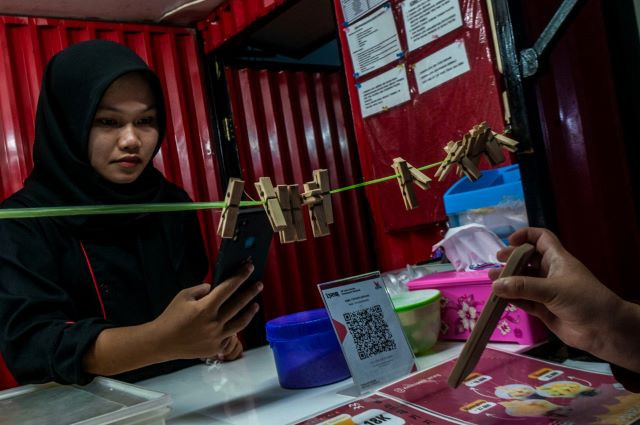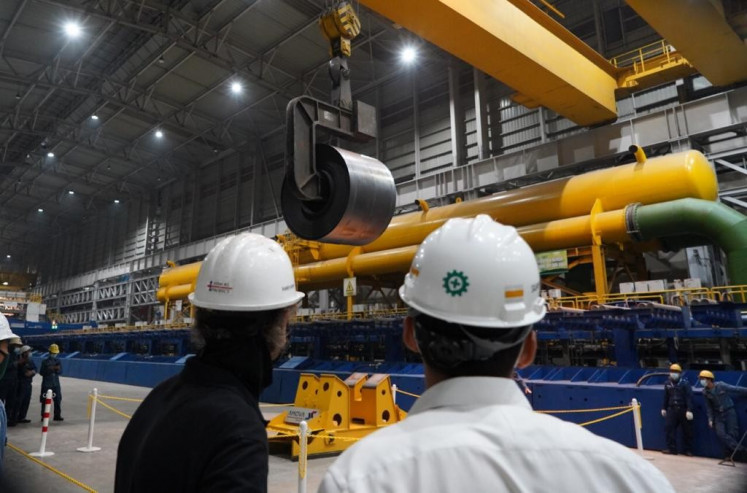Popular Reads
Top Results
Can't find what you're looking for?
View all search resultsPopular Reads
Top Results
Can't find what you're looking for?
View all search resultsIt’s time for one big payment network in South and Southeast Asia
Greater connectivity between payments networks is a step toward a friction-free financial future for businesses and consumers in South and Southeast Asia.
Change text size
Gift Premium Articles
to Anyone
 Digital society: A customer settles a transaction using the Quick Response Indonesian Standard (QRIS) code in Rangkasbitung, Banten, on May 3, 2023. Bank Indonesia has recorded a 40 percent growth in the number of users of the digital payment method in Banten from 1.32 million in February 2022 to 1.72 million in February 2023. (Antara/Muhammad Bagus Khoirunas)
Digital society: A customer settles a transaction using the Quick Response Indonesian Standard (QRIS) code in Rangkasbitung, Banten, on May 3, 2023. Bank Indonesia has recorded a 40 percent growth in the number of users of the digital payment method in Banten from 1.32 million in February 2022 to 1.72 million in February 2023. (Antara/Muhammad Bagus Khoirunas)
F
aster and more efficient payments allow businesses to cut costs and allow consumers to shop with convenience and confidence. At the country level, the data tells us that real-time payments can deliver a boost to overall economic activity. But a network of real-time payments networks, linking all the major economies in South and Southeast Asia together, could amplify that boost across the whole region.
It makes sense for this region to build what would amount to one big real-time payments network, but we should acknowledge that it won’t be easy. Connecting one nation’s real-time payments network with that of another country is not as simple as installing some software and pushing a button. In a region that has a mosaic of different capital controls and foreign exchange regulations, this painstaking task will require diplomacy as much as technology.
But the potential benefits to businesses and consumers mean that the emergence of this network isn’t just possible, it’s ultimately inevitable. That’s why we expect the real-time payments networks of at least five ASEAN countries and India to be linked with each other within the next five years.
The technology and the momentum are already in place. South and Southeast Asia have drawn recognition for building some of the world’s best real-time payments systems. Because they are simple, secure, and seamless to use with local banks and merchants, platforms such as Thailand’s PromptPay, Malaysia’s DuitNow, Indonesia’s BI-Fast, Singapore’s PayNow and India’s Unified Payments Interface (UPI) have quickly gained traction with businesses and consumers.
These networks have now started to connect. In June, Malaysia and Indonesia made it possible for travellers between the two countries to make payments in the other’s local currency using QR codes. Last month, a Bank Indonesia official said that travellers between Indonesia and Singapore would be able to do the same by the end of this year.
This followed the launch in February by the Monetary Authority of Singapore (MAS) and the Reserve Bank of India of a groundbreaking link between PayNow and UPI. As more of these connections come online, a pan-regional network is beginning to take shape.
Real-time payment volumes are surging in Asia. Government initiatives to reduce cash usage and digitize payments during the pandemic have been a catalyst for this shift. But so have digital wallets, which bring easy access to financial services to previously underserved populations.
India’s UPI has been wildly successful: nearly 300 million people and 50 million merchants reportedly use the platform. Its volume of payments in June reached the equivalent of US$180 billion, up 45 percent year-on-year and more than tenfold the amount processed in June 2019.
Singapore’s PayNow has achieved similar growth in a more developed economy: payments on the Fast and Secure Transactions (FAST) infrastructure that PayNow uses reached the equivalent of nearly $287 billion in 2022, up 28 percent year-on-year and more than double pre-pandemic volumes in 2019.
The rapid adoption speaks to the benefits to both businesses and consumers. Lower fees, reduced settlement times and improved risk management promote innovation and financial inclusion, boosting economic productivity. According to a study by the Centre of Economics and Business Research, India’s UPI unlocked more than half a percentage point of total economic output in 2021. It is reasonable to expect that the ability to use similar technology for cross-border payments would also boost consumption and commerce across the wider region.
However, this will require increased ambition in the scope of connections between real-time payment networks. At present, these are largely intended to make payments easier for travelers. Building a more digital, more connected economy across South and Southeast Asia would require these links to be used for cross-border payments to merchants in other countries, too.
This kind of integration would create a wealth of opportunities for businesses to expand internationally – and new choices for consumers.
E-commerce already accounts for one fifth of retail sales in Southeast Asia, according to McKinsey, and a cross-border payments network would allow companies to reach millions of new consumers without the need for credit cards or time-consuming remittances.
Faster cross-border payments will support the continued expansion of commerce along South and Southeast Asian corridors. With high smartphone penetration, a growing middle class and total trade volumes in Southeast Asia rising an impressive 15 percent in 2022, the commercial opportunities from deeper digital connections are compelling.
But the reality of connecting different countries’ payment rails is highly complex.
policymakers need to consider capital controls and foreign exchange requirements. The financial institutions involved need to address different data formats and legacy technology stacks. And both must find ways to manage a range of regulatory approaches to data privacy and know-your-customer checks.
These layers of complexity show why integrating any two payment systems is a significant achievement – and why India and Singapore rolled out the PayNow-UPI connection in a carefully-phased manner.
Governments naturally must ensure that integrating their payment systems with other countries will not have unintended, negative impacts. But while policy has to lead any linkage of sovereign infrastructures, banks also have an important role to play in this process.
International banks’ experience and capabilities in cross-border payments – HSBC itself processes 142 corporate payments per second – means we can support government bodies in different markets as they test and expand the network of connected payment systems.
This is a valuable contribution that banks can make to the region’s economic development – and there is every incentive for them to do so given the expected boost to the cross-border flows that we intermediate and for all the economies involved.
New tools will help. This year’s launch of SWIFT’s Cross-border Payments and Reporting Plus (CBPR+) migration program, along with ISO 20022, should help resolve the fragmentation of messaging formats that banks use today, for example.
Ultimately, though, building a network of connected real-time payment networks will require the kind of pioneering, government-level effort that has so far forged these bilateral links. There is a sound economic rationale for policymakers to make this effort – and for banks to support it.
***
The writer is cohead of global payments solutions for Asia Pacific at HSBC.










